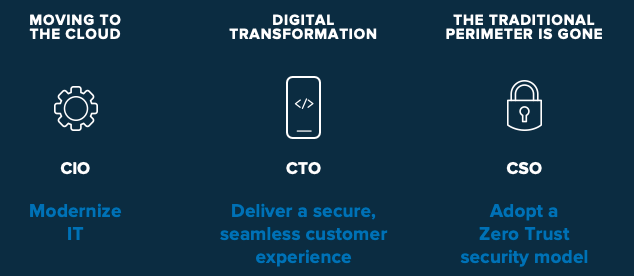Spring Cleaning for the Enterprise: Reduce Complexity, Cost, and Vendors
As they strive to meet the demands of today’s technical landscape, there’s a new challenge arising for the world’s largest organizations. These external demands can be summed up in 3 pressing imperatives that all enterprises must embrace:
- Deliver on modernize IT initiatives
- Create secure and seamless customer experiences
- Adopt a zero-trust security model
In the past, Identity and Access Management has been viewed as more of a technology issue than a business concern. This perspective, however, has led IT teams to invest in technologies as a means to address urgent issues—not as a strategic approach to security.
This lack of strategy has created a fragmented approach to addressing the needs of the business, and an “alphabet soup” of vendors and technical debt. Specifically, this “whack-a-mole” response has caused:
- Increasing complexity due to custom code
- Fragile, inflexible workflows
- A lack of automation
- Multiple Active Directory instances
- Needlessly complex architecture
- A lack of agility
Again, these issues have contributed to a higher Total Cost of Ownership for most large-scale, enterprise organizations.
An Identity and Access Management strategy must be in your future
According to the site Market Research Engine, by the year 2024 the Identity and Access Management (IAM) global market will grow to $22.8 billion. In other words, any forward-thinking, digital transformation strategy includes an IAM infrastructure. So, for enterprise organizations, any competitive advantage relies on the ability to address these market conditions.
And the imperatives are clear: today’s business environment assumes at least a partial (if not complete) move to the cloud, and a security posture that allows losing the traditional perimeter and embracing zero trust—where identity is foundational.
And the C-suite is taking the lead
In consideration of scale, these issues can be felt in various ways throughout an enterprise organization. CIO, CTOs and CSOs each have unique issues and needs around Identity.
CIOs see identity as critical to modernizing IT
Modern identity enables you to roll out new technology quickly. It reduces the complexity of managing separate authentication policies across on-premises and cloud apps, and allows automation of provisioning and de-provisioning.
CTOs see identity as critical to delivering a seamless customer experience
Identity is now a service you can simply embed into your application development lifecycle. This allows developers to focus on customer experience, without worrying about the burden of auth security. For delivering a secure, seamless customer experience, it’s a requirement.
CSOs see identity as critical Zero Trust
As more and more large-scale organizations embrace a cloud and mobile world, identity becomes the safe, single control point. By encapsulating users, devices, and networks, it's the critical foundation needed to adopt a Zero Trust security model.
A forward-thinking approach for both workforce and customer identity
For the workforce, the truly strategic approach to identity must have the attributes of an independent and neutral platform to connect faster, and with deeper connections for automation. It must connect the workforce at the right time, with the right context with best-of-breed, cloud applications, infrastructure, as well as strategic legacy applications with a unified experience that is seamless and secure.
The customer identity platform must serve to accelerate growth, with new ways of engaging customers in a frictionless experience. In addition, accelerate the development life cycles for customer-facing applications to enable faster go to market strategies or in building out an API ecosystem.
Organizations are considering a path that integrates customer identity and access management (CIAM) into their IAM strategies—commonly known as CIAM and IAM convergence. In taking this forward-thinking approach, large enterprises can gain a sustainable advantage. How? By using identity to do the following:
- Tie security to broader business initiatives
- Decrease cost while increasing efficiency
- Accelerate growth through a technical strategy
Beyond tightening up—it's time to spring clean
So, if your leadership has yet to embrace these advances, it's time for a serious spring cleaning. The complexity and technical debt developed by years of legacy architecture and a lack of strategy has become an albatross that is no longer required.
The modern IAM approach allows for a shift that accelerates growth and decreases costs, while also mitigating risk. It enables greater productivity, better engagement with your customers, and secures your business, globally.
Although we were built in the cloud, Okta has a solution and a strategy that not only expands to the enterprise, but allows large-scale organizations to innovate and thrive—and we have the customers to prove it. To meet their needs, we created the IAM category, and since its inception, we’ve led the Gartner Magic Quadrant and Forrester Wave in our execution.
Need to know more before you embrace the future? Check out our Modern Infrastructure and Development: Using Identity to Scale for Tomorrow’s Technology whitepaper.


